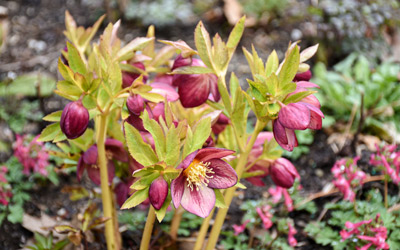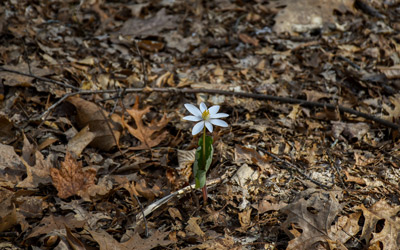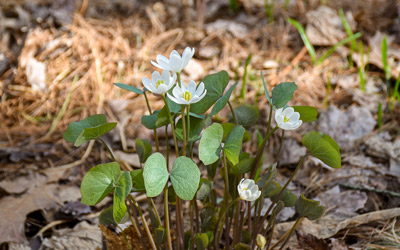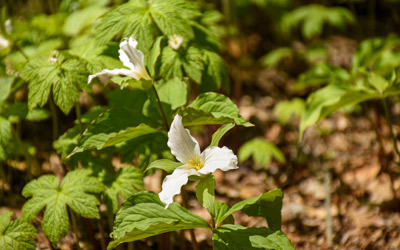April Blooms
The springtime panoramas at New England Botanic Garden are unmatched in the region. From the Field of Daffodils to the tens of thousands of spring bulbs blooming, there is such a variety to see and do. During your April visit, check out these spring favorites in bloom.

Hellebore (Helleborus cultivars)
With green, white, pink, or purple—sometimes even spotted—petals, hellebores are a popular spring flower at the Garden. These perennials usually grow between 12-15 inches tall and are well-known for their cup-shaped flowers. Occasionally, hellebores come in a double-flowered form where the number of petals increases drastically. With a long bloom period, these flowers typically begin blooming in late March and continue through April and often into May.
Location(s): The Lawn, Cottage, and Shade Gardens

Bloodroot (Sanguinaria canadensis)
A native New England ephemeral, bloodroot has striking flowers that are bright white and stay that color until the flowers drop at the end of their short bloom period. Upon first emergence in the spring, the flowers are wrapped in a leaf, which can be an interesting sight to behold. Despite the short bloom period, the leaves of this plant persist much longer and can often be just as beautiful as the flowers. At the Garden, bloodroot can be found blooming in April in the Inner Park.
Location(s): The Inner Park

Common hyacinth (Hyacinthus orientalis cultivars)
Hyacinths come in a variety of different colors, ranging from blue to purple to white. The flowers are native to the Mediterranean and Iran. A bulbous perennial, hyacinth can grow to a height of 12 inches. The flowers are edible and can be made into jams.
Location(s): Throughout the Garden, primarily in the Garden of Inspiration, and Lawn, Secret, and Entry Gardens

Twinleaf (Jeffersonia diphylla)
Right place, right time is important when it comes to seeing the flowers of this interesting plant. The small, delicate white blooms of twinleaf only stick around for a handful of days. The blue-green foliage is what truly sets this almost-spring-ephemeral plant apart, lasting longer and growing larger over the weeks following the bloom’s end. Twinleaf will begin flowering in early April, depending on the weather.
Location(s): The Inner Park

Magnolia (Magnolia spp. and cultivars)
The genus Magnolia has around 100 species in addition to hybrids and cultivars. These trees and shrubs feature large leaves and showy flowers that occasionally are fragrant. Most magnolias have pink, purple, white, or yellow flowers. They bloom in early spring before or as the leaves emerge, or into summer when the leaves have fully emerged. At the Garden, the white blooming M. × loebneri ‘Merrill’ typically blooms first in the year, followed by the pink blooming M. × soulangeana ‘Alexandrina,’ then the yellow blooming M. ‘Elizabeth.’ Other magnolias across the Garden can be found blooming further into the summer.
Location(s): The Lawn and Shade Gardens, Garden of Inspiration, and The Ramble

Daffodil (Narcissus spp. and cultivars)
The Garden’s daffodils come in various shades of yellow, white, and cream, and are often tinged with pinks and oranges. Spring sunshine in flower form, these reliable perennial bulbs are one of the cornerstones of the early growing season. Bloom time varies from late March to early May depending on the cultivar. On your visit, explore the Garden’s Field of Daffodils — a sloping hillside with more than 25,000 daffodils.
Location(s): From the Daffodil Field, The Court, and Garden of Inspiration to the Cottage, Lawn, Secret, and Entry Gardens

Redbud (Cercis canadensis)
Redbuds are deciduous, often multi-trunked understory trees. They have what could be considered the showiest flowers of New England’s native trees. When in bloom—which often occurs in early April and continues throughout the month—the trees showcase vibrant fuchsia flowers that look like they’re bursting from the seams of the tree’s branches. Redbuds have an interesting trait called “cauliflory,” which refers to the tree’s ability to produce flowers directly from its trunk and lager branches.
Location(s): The Lawn and Cottage Gardens and Inner Park

Great white trillium (Trillium grandiflorum)
These simple perennials are some of the most familiar and cherished wildflowers in the Northeast. Native from Quebec to Minnesota and south to Alabama and Georgia, these spring ephemerals are some of the first blooms to grace forest floors come springtime. Single flowers emerge as early as April with three white petals. As the flower ages, the petals turn a pink blush color toward their center. Once trillium are pollinated and produce seed, ants will disperse the seed, making the beautiful plant spread quickly.
Location(s): The Inner Park, naturalistic spaces
